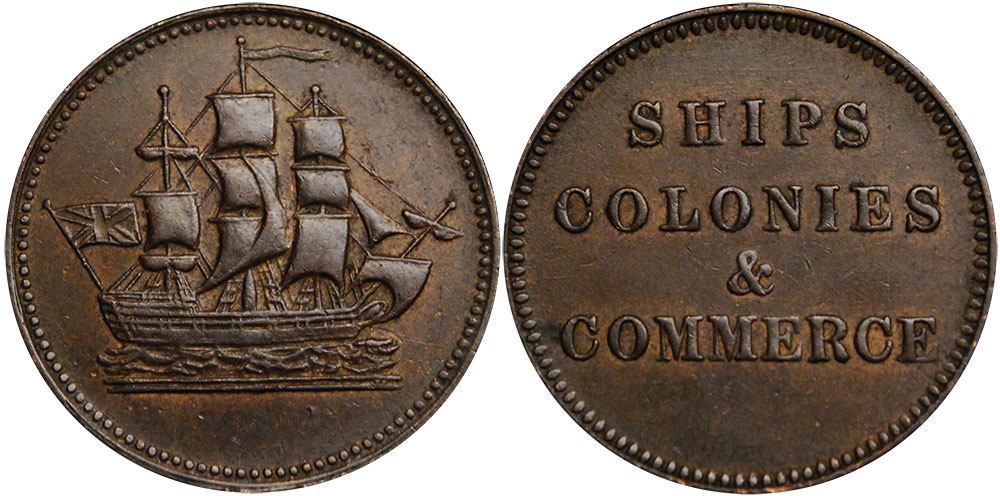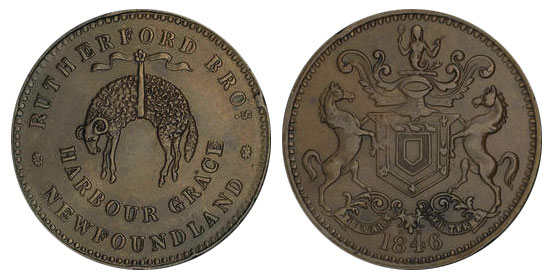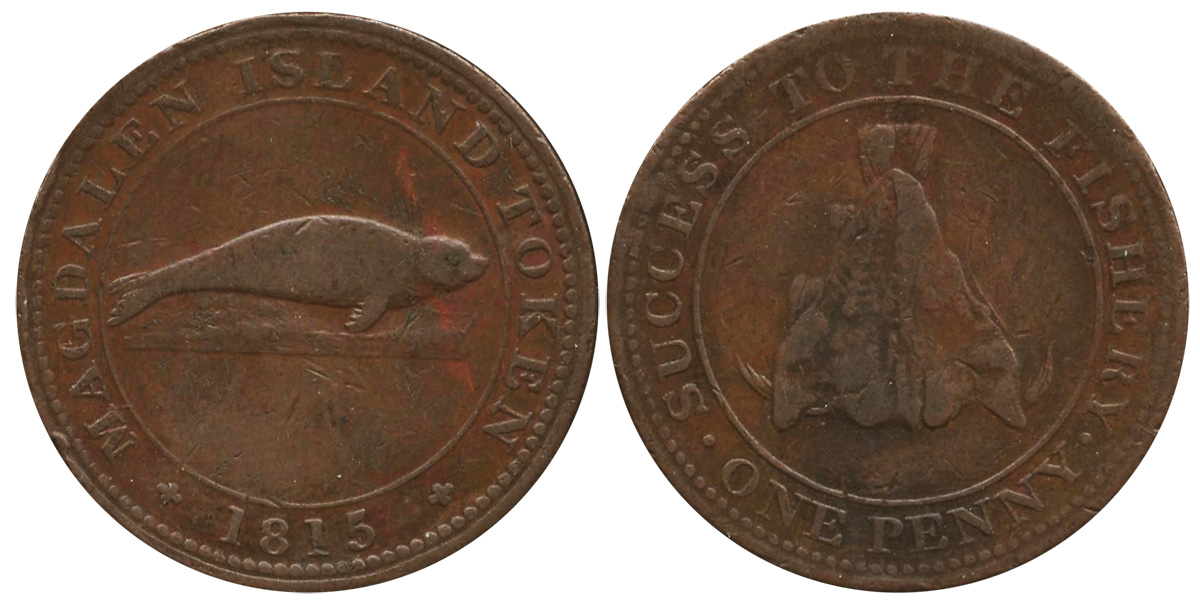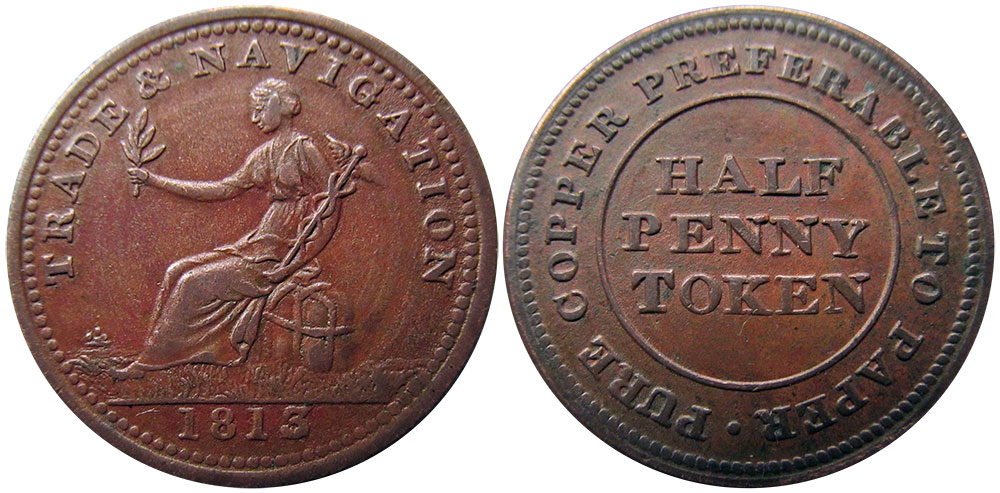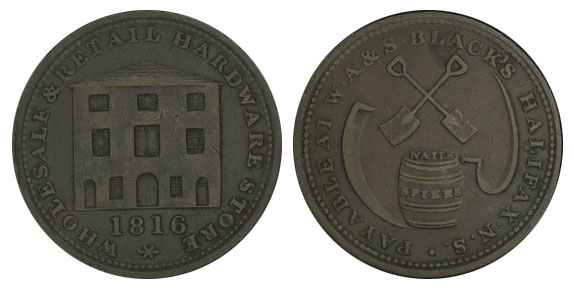Tokens of the colonies of the British Empire: Canada
By Coinsanduk | Thursday, 4 June 2020
In 1763 France and England signed the Treaty of Paris and Canada became a British possession. Sixty years later the mother country had made no effort to provide an official currency for the young colony. By this time several private banks were in operation and they issued paper money which served to facilitate large business transactions. It was in the market place, where the ordinary citizen had to make change for small purchases, that the situation was most keenly felt.
The metallic currency in circulation consisted mainly of British and foreign coins (French, Spanish, Dutch, Portuguese and American), many so worn as to be almost unidentifiable. At this time several banks and a number of merchants began to issue copper tokens to meet the need for small change. Furthermore, extensive quantities of low-denomination tokens were imported from England by merchants hoping to facilitate business in the colonies and make a profit on the tokens. Some of these tokens were anonymous, that is, they did not indicate the name of the merchant who had imported them, while others carried the name of the merchant, such as Lesslie & Co. of Toronto.
Here's a short list these tokens. They all can be found on Coinsandcanada.com.
Ships, Colonies & Commerce - Prince Edward Island
One of the commonest kinds of metallic tokens issued in Canada by merchants and others to alleviate the shortage of coins were the ones bearing a ship on the obverse side and the inscription SHIPS, COLONIES & COMMERCE on the reverse. The inscription refers to the famous statement made by Napoleon in 1811 that ships, colonies and commerce were the three British advantages that would defeat him in the end. The first of these tokens were produced in the United States and showed a ship flying the U.S. flag. Later issues were struck in England and portray a ship flying the Union Jack.
Most of these later tokens seem to have been originally intended for circulation in Prince Edward Island where they were very popular. By the early 1860s, however, barrels full of them were being smuggled from Prince Edward Island into Newfoundland. This was a profitable enterprise due to the difference in the value of the currencies of the two colonies: Newfoundland currency was worth more and so the tokens specifically struck for use there tended to be heavier (and hence more costly) than those struck for use in Prince Edward Island. The Newfoundland government was soon forced to ban the Prince Edward Island tokens.
Rutherford Brothers - Newfoundland
Newfoundland, like other parts of British North America, suffered from a chronic shortage of small denomination coins during much of its early history. The British government made no effort to provide a local currency and the islanders had to make do with an insufficient supply of badly worn foreign coins. Finally, as had happened elsewhere, the local merchants decided to take matters into their own hands. The first to do so were the Rutherfords, who operated a store in St. John's under the name of R. & I. S. Rutherford and another in Harbour Grace under the name of Rutherford Bros. Three tokens of similar designs were issued, all with a nominal value of a halfpenny. Two were for use in St. John's, one with no date and the other dated 1841 and a third, dated 1846, for use at Harbour Grace.
The arms of the Rutherford family are on one side of the token and a suspended sheep carcass on the other. The sheep design, copied from an English trade token, had little relevance to Newfoundland. Perhaps the only explanation for its use is that the tokens were manufactured in England. The original tokens were made of copper but brass counterfeits soon appeared. So great was the shortage of coins in Newfoundland at that time that the counterfeits were readily accepted and circulated freely along with the genuine pieces. It was not until 1865 that the first official coins were issued by the government.
Magdalen Islands - Lower Canada
The Magdalen Islands, a group of 16 islands situated in the Gulf of St. Lawrence, were discovered by Jacques Cartier during his voyage to the Gaspe in 1534. The islands were granted to Sir Isaac Coffin in 1787 in recognition of the Boston-born Admiral's loyal service to Britain during the American War of Independence. Fancying himself somewhat of a feudal lord, Sir Isaac decided to introduce his own coinage of pure copper penny and halfpenny tokens to his North American possessions. In 1815 an issue of penny tokens produced in Birmingham, England, was sent out to the Magdalens and distributed to the local fishermen.
However, when the British authorities learned that Coffin had ordered a private coinage, he was duly informed that the right of coinage was vested only in the Crown. Following this, it appears that halfpennies were never produced. The choice of subjects depicted on Coffin's penny token was, and indeed still is, appropriate. The obverse shows a fur seal, while the reverse features a split codfish - thus denoting the main resources of the islands. It is interesting to note that although these tokens did not receive royal approval they apparently did circulate extensively and, as a result, few examples are found in mint condition.
Tiffen - Lower Canada
Nowhere in British North America did the private copper tokens issued by merchants and others have a more fascinating evolutionary history than in Lower Canada - now Quebec. In the 1820s and 1830s, trade in Montreal, the colony's commercial centre, created a strong demand for coinage. As coins were often in short supply, privately produced tokens filled the void. Tokens were not legal tender and their circulation was against the law. However, this was little deterrent at a time when legal coins were scarce. The first private coppers were heavy pieces, about the same weight as the penny and halfpenny coins they supplemented.
However, by the 1830s the tokens were barely half the weight of the official coins and, at times, were so numerous that people would no longer accept them. Various tricks were therefore resorted to in order to make their circulation possible. One interesting approach was to copy the designs of tokens that had previously been of heavy weight and had enjoyed wide circulation. About 1832 a Montreal grocer named Tiffin issued copper halfpenny tokens. They bore the date 1812 and were imitations of much heavier pieces produced twenty years earlier. The obverse carried a bust of King George III surrounded by a wreath of oak leaves and acorns and the figure of a seated woman representing Commerce was the design on the reverse.
Sir Isaac Brock - Upper Canada
In the opening phases of the War of 1812, Major General Sir Isaac Brock, commander of the British forces in Upper Canada, distinguished himself in his untiring efforts in the province's defence, culminating with a decisive victory over the U.S. forces at Detroit. Brock was killed on October 13, 1812 during an attack by invading U.S. forces at Queenston Heights on the Niagara frontier. During the war, private tokens began circulating in great quantity in British North America due to a severe currency shortage caused by increased commercial activity, and to an initial distrust of the series of paper notes known as army bills issued by Brock. As a consequence, individual merchants ordered large supplies of copper tokens from commercial mints in Birmingham, England. After Brock's death, a series of halfpenny tokens recognizing him as The Hero of Upper Canada were put into circulation by an unknown issuer.
Trade & Navigation - Nova Scotia
During the early part of the nineteenth century, Halifax was a major British military station as well as a trans-shipment point for supplies being sent from the United States to Europe to help the British in their struggle against Napoleon. This increased commercial activity intensified the port's need for small change, a commodity that had always been in short supply. Great Britain was in no position to come to the colony's aid at this time, since she herself was depending largely on the private production and circulation of copper tokens. Therefore Nova Scotia had to turn to private sources of supply, and the earliest tokens imported into the colony are believed to have been the Trade & Navigation copper pennies, halfpennies and farthings.
Their circulation is attributed to a Halifax merchant named Haliburton, although they were undoubtedly imported into or at least circulated in other parts of British North America as well. The figure represents Commerce, an olive branch in her outstretched right hand and a caduceus in her left. She is seated on a bale of goods and a sailing ship can be seen in the background. The tiny H on the ground at the lower right indicates that the manufacturer of the token was Thomas Halliday of Birmingham, England. On the reverse is the interesting legend PURE COPPER PREFERABLE TO PAPER, suggesting the suspicion with which people of the time often viewed paper money.
W.A. & S Black - Nova Scotia
In the 18th century, Nova Scotia received occasional shipments of English pennies and halfpennies. However, after the American Revolution the shipments became fewer, and after 1795 they stopped altogether. In the early 19th century the colony was so short of copper coinage that, about 1814, some of the individual merchants of Halifax began to import halfpenny tokens from England to alleviate the chronic shortage of small change.
This token was issued in 1816 by the hardware merchants W.A. and S. Black of Halifax, is an excellent example of a merchant's advertising piece. The scythe, crossed shovels, sickle and keg - inscribed NAILS at the top and SPIKES on the side - clearly indicate the business of the issuer. The firm was established circa 1812 by William Anderson Black and his brother Samuel, the sons of the Reverend William Black, one of the founders of Methodism in Nova Scotia.
Canadian colonial tokens price guide and values »

